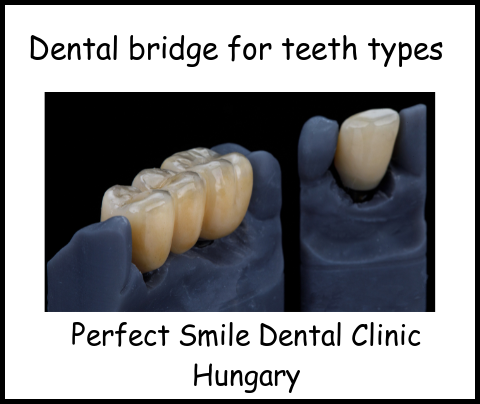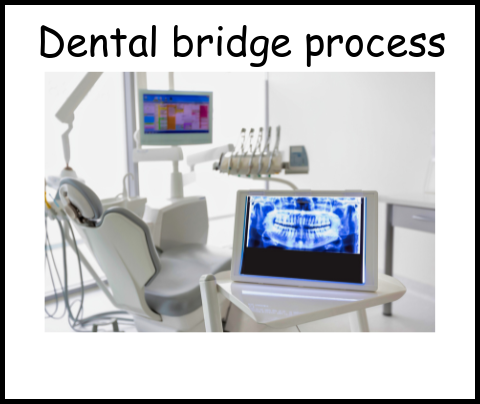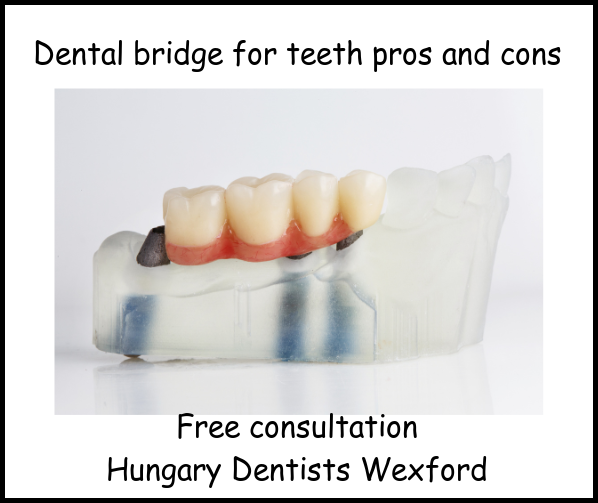Dental bridge for teeth
A dental bridge for teeth is used by dentists to replace teeth that are missing.
A dental bridge can help to get chewing function back, in addition it can improve oral health and enhance your appearance.
It is made up of crowns that are a perfect fit over the natural teeth on each side of the gap and the artificial teeth.
The artificial teeth is the bridge that covers the space left by missing teeth.

Bridges the gap
Basically, a dental bridge bridges the gap where there are no teeth.
A dental bridge will do a great job at replacing missing teeth.
More specifically a dental bridge can be a replacement for one or more missing teeth.
It’s called a dental bridge for teeth because it literally bridges the gap in a patient’s smile.
The dental laboratory in Perfect Smile Dental Clinic Hungary will create a custom bridge that matches the colour of natural teeth.
Talk to us at Hungarian Dentists Wexford town clinic, we can help with dental bridge for teeth and the cost.
Several parts to a dental bridge
There are several parts that go into making a dental bridge for teeth.
Abutment
The abutment is a support structure for the bridge, abutment is often referred to as natural teeth.
In reality an abutment is a very small connector post that dentists use for a dental implant supported bridge.
Pontics
Pontics are the man-made ( artificial) teeth that are gap fillers where no teeth exist.
During the free consultation in Hungarian Dentists Wexford you have the opportunity to talk about a dental bridge.
Our dentist will make a decision on how many abutments or pontics are needed for your particular situation.

Dental bridge types
Your oral health will determine dental bridge types to be used, there are four:
1.Standard dental bridge
A standard or traditional dental bridge is most commonly used for missing teeth.
It is made up of a dental crown or crowns on each end of the bridge.
The pontics or artificial teeth are situated in between the crowns
2.Cantilever dental bridge.
This type of bridge is somewhat the same as the traditional bridge, the only difference is one crown on the end not two.
Once the dentist has bonded your bridge onto the abutment the pontiac (artificial tooth) extends across the gap.
A cantilever bridge can only be used where natural teeth exist on one side of the gap.
Because of their design they would not be as robust as a standard bridge.
3.Implant supported bridge
The implant supported bridge is placed on top of dental implants, it is similiar to the standard bridge but implants are used in this case.
A dental implant is a small post set into the jawbone that is threaded for an abutment.
This process typically takes 4-6 months because the implants must completely fuse into the jawbone.
An implant supported bridge would be used where three or more teeth in a row missing.
4.Maryland dental bridge
A maryland bridge otherwise known as a resin-bonded bridge utilizes metal wings not crowns to make the bridge secure.
Our dentist will bond the metal wings to the back of the adjacent teeth, that holds the bridge in position.
A maryland bridge will only be used where front teeth are missing.
They are not strong enough for the back teeth area because chewing forces there are more excessive.
Which bridge is best for you
To find out which bridge is best for you, our dentist will need to look at several factors:
- How old you are
- The number of missing teeth
- The diameter of the gap
- The condition of teeth adjacent to the gap
- The health overall of your gums and teeth
- Are there natural teeth either side of the gap
- What is your preference

Dental bridge procedure
Getting a dental bridge is straightforward enough, it involves the following:
1. Preparation of the abutment teeth:
The dentist will reshape the abutment teeth by removing a small amount of enamel from them.
This will allow room for the dental crowns that will support the bridge.
2. Impression taking:
The dentist will take an impression of the prepared teeth and the surrounding area.
This impression will be used to create a model of your teeth, our technican in the lab will custom make the bridge for your teeth.
3. Temporary bridge placement:
The dentist may place a temporary dental bridge to protect the prepared teeth.
Its important to maintain the appearance of your smile while the permanent bridge is being made.
4. Placement of the permanent bridge:
Once the permanent ridge is ready, the dentist will check the fit and make any necessary adjustments.
Once the dental bridge fit is satisfactory, the bridge will be cemented in place.
5. Follow-up care:
The dentist will schedule a follow-up appointment to ensure the dental bridge for teeth is functioning properly and to address any concerns you may have.
Proper oral hygiene and regular dental check-ups are essential for the longevity of a dental bridge.
It’s important to note that the specific steps and details of the procedure may vary.
A lot will depend on the individual case and the dentist’s clinical approach.
Patients should discuss the specific details of their treatment plan with their dentist.

Dental bridge pros and cons
Much like every dental procedure there are pros and cons.
Pros
They are an effective and natural looking solution for missing teeth.
A dental bridge for teeth will restore the natural chewing ability that real teeth provide.
In addition missing teeth can affect speech, a dental bridge can improve speech.
Neighboring teeth are prevented from moving into gaps made when teeth are missing.
Cons
If something should happen to the abutment such as trauma or decay the dental bridge could weaken.
If the abutment supported teeth aren’t tough enough to keep the bridge supported they may fracture.
If proper mouth hygiene isn’t followed, such as proper cleaning of the bridge and the tissue underneath. It can cause inflammation or cavities to develop.
Recovery time
The recovery time following the dental bridge placement will vary. A good rule of thumb is one to two weeks for the gums to heal.
The new dental bridge may take a little longer before it feels comfortable and natural.
Lifespan of a dental bridge
Proper care and regular check-ups are essential to the lifespan of a dental bridge.
The average lifespan is between 1-15 years, some bridges may go even further than that.
Are bridges permanent
Dental bridges are “permanent” in that they can only be removed by a dentist.
In terms of permanency, they won’t last forever, once the signs of wear and tear appear they’ll need to be replaced.
How long to get used to them
It shouldn’t take more than a few weeks before you feel entirely comfortable with your new dental bridge.
Like anything new you know it’s there and you become accustomed to it after a while.
Caring for a dental bridge
Caring for a dental bridge is much the same as caring for your own natural teeth.
You should use an electronic toothbrush, flouride toothpaste and brush your teeth at least twice a day.
The dental bridge must be cleaned underneath each day with a floss threader or an interproximal brush.
You should avoid eating very hard or chewy foods.
Don’t put any hard objects into your mouth.
Book regular check-ups at the clinic.

Conclusion
I hope that this post on a dental bridge for teeth has provided enough information for you.
If you are in a situation where 1-4 teeth im a row are missing, then a dental bridge could well be a good option for you.
A bridge placed by a professional dentist are much more comfortable when you compare them to partial dentures.
They cost a bit more than dentures but cost less than dental implants.
Talk to us at Hungarian Dentists in Wexford, we can help you decide which option is best for you.
References
https://www.ncbi.nlm.nih.gov/books/NBK596304/
https://academic.oup.com/jom/article/doi/10.1093/jom/ufab030/6459926

